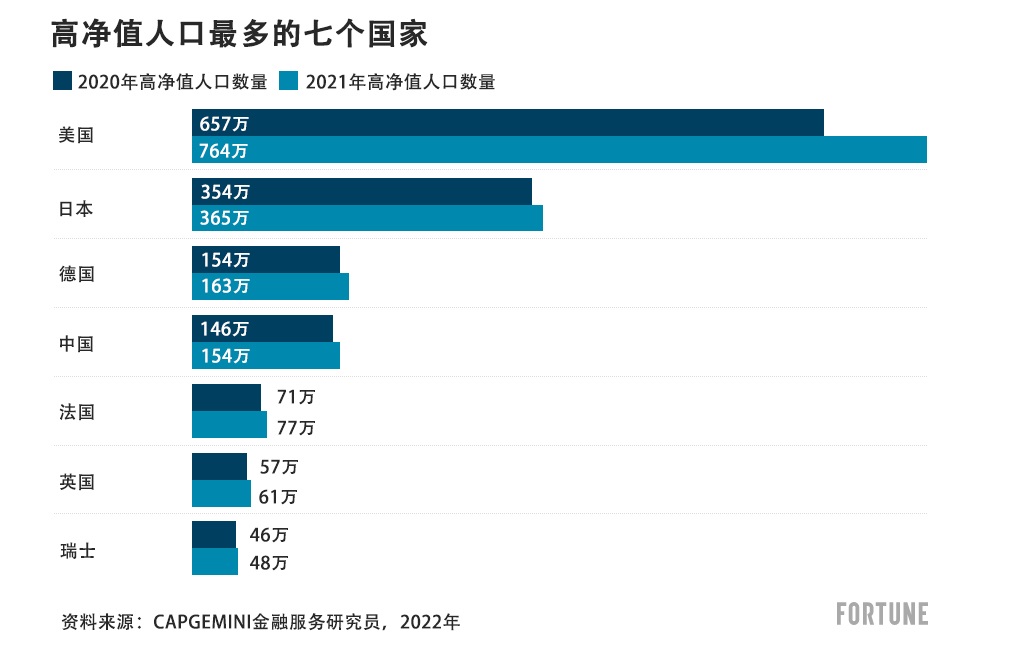
去年,,美國富人規(guī)模持續(xù)壯大,,而且疫情之后的經(jīng)濟(jì)復(fù)蘇顯然幫助富人不斷增加財(cái)富。
Capgemini的《2022年世界財(cái)富報(bào)告》(World Wealth Report 2022)顯示,,美國百萬富翁人數(shù)從2020年的660萬增加到2021年的750萬,,增長了13.5%。2021年,,美國不僅高凈值人士的數(shù)量增加,,富人也在變得更加富有,他們的資產(chǎn)凈值增長了約14%,。高凈值人士的增多,,主要得益于股市投資,尤其是對(duì)科技行業(yè)的投資,。
高凈值人士的資產(chǎn)凈值必須超過100萬美元,,不包括其主要住宅以及收藏品、汽車等資產(chǎn),。
北美高凈值人士的數(shù)量增長了13.2%,。北美高凈值人士數(shù)量和財(cái)富增長幅度最大,成為高凈值人士最集中的市場(chǎng),。

全球資產(chǎn)價(jià)值超百萬美元的人口數(shù)量增長了約8%,。美國、日本,、德國,、中國,、法國、英國和瑞士是高凈值人口最多的七個(gè)國家,。
但Capgemini警告,,雖然2021年高凈值人口大幅增長,但2022年的趨勢(shì)可能有所變化,。研究人員表示:“自2022年初以來的高通脹和央行加息的消息,,正在刺激股市加快回調(diào)?!?/p>
這可能產(chǎn)生巨大影響,,尤其是因?yàn)槿ツ旮邇糁等丝诘脑鲩L主要基于股市的表現(xiàn),許多高凈值人士很大一部分財(cái)富與股票掛鉤,。在北美,,百萬富翁總投資額的32%是股票,全球平均比例只有29%,。
Capgemini估計(jì),,截至4月底,全球高凈值人士的財(cái)富總額已經(jīng)比2021年減少了約4%,。研究人員寫道:“由于股票的占比較高,,北美高凈值人士的財(cái)富預(yù)計(jì)將受到最大影響,其次是歐洲,,因?yàn)闅W洲同樣面臨地緣政治危機(jī)?!保ㄘ?cái)富中文網(wǎng))
譯者:劉進(jìn)龍
審校:汪皓
去年,,美國富人規(guī)模持續(xù)壯大,而且疫情之后的經(jīng)濟(jì)復(fù)蘇顯然幫助富人不斷增加財(cái)富,。
Capgemini的《2022年世界財(cái)富報(bào)告》(World Wealth Report 2022)顯示,,美國百萬富翁人數(shù)從2020年的660萬增加到2021年的750萬,增長了13.5%,。2021年,,美國不僅高凈值人士的數(shù)量增加,富人也在變得更加富有,,他們的資產(chǎn)凈值增長了約14%,。高凈值人士的增多,主要得益于股市投資,,尤其是對(duì)科技行業(yè)的投資,。
高凈值人士的資產(chǎn)凈值必須超過100萬美元,不包括其主要住宅以及收藏品,、汽車等資產(chǎn),。
北美高凈值人士的數(shù)量增長了13.2%,。北美高凈值人士數(shù)量和財(cái)富增長幅度最大,成為高凈值人士最集中的市場(chǎng),。
全球資產(chǎn)價(jià)值超百萬美元的人口數(shù)量增長了約8%,。美國、日本,、德國,、中國、法國,、英國和瑞士是高凈值人口最多的七個(gè)國家,。
但Capgemini警告,雖然2021年高凈值人口大幅增長,,但2022年的趨勢(shì)可能有所變化,。研究人員表示:“自2022年初以來的高通脹和央行加息的消息,正在刺激股市加快回調(diào),?!?/p>
這可能產(chǎn)生巨大影響,尤其是因?yàn)槿ツ旮邇糁等丝诘脑鲩L主要基于股市的表現(xiàn),,許多高凈值人士很大一部分財(cái)富與股票掛鉤,。在北美,百萬富翁總投資額的32%是股票,,全球平均比例只有29%,。
Capgemini估計(jì),截至4月底,,全球高凈值人士的財(cái)富總額已經(jīng)比2021年減少了約4%,。研究人員寫道:“由于股票的占比較高,北美高凈值人士的財(cái)富預(yù)計(jì)將受到最大影響,,其次是歐洲,,因?yàn)闅W洲同樣面臨地緣政治危機(jī)?!保ㄘ?cái)富中文網(wǎng))
譯者:劉進(jìn)龍
審校:汪皓
The ranks of rich Americans continued to swell last year—and the economic recovery from the pandemic certainly helped the rich continue to get richer.
The number of U.S. millionaires grew from 6.6 million in 2020 to 7.5 million in 2021, reflecting a 13.5% increase, according to Capgemini’s World Wealth Report 2022. Not only did more Americans enter the elite ranks of the high-net-worth (HNW) population in 2021, but the rich got richer, with their net worths increasing by about 14%. The growth was mostly spurred by investments in the stock market, with a particular focus on the technology sector.
In order to be considered HNW, individuals must have a net worth of more than $1 million, excluding their primary residence, as well as assets like collectibles and cars.
Across North America, the HNW population grew by 13.2%. Overall, North America had the highest increase in terms of both HNW population and wealth growth—helping the market clinch the top slot for the greatest concentration of wealthy individuals.
Globally, the population of those with more than a million in assets grew by about 8%. Along with the U.S., Japan, Germany, China, France, the United Kingdom, and Switzerland, respectively, rounded out the top seven countries with the highest HNW populations.
But Capgemini warns that while 2021 was a strong growth year, 2022 could see different trends. “High inflation since the start of 2022 and talk about interest rate hikes from central banks have spurred stock market corrections that are accelerating,” the researchers write.
That could have big implications, especially since much of the growth seen last year was based on stock market performance—and many of these HNW individuals have major portions of their wealth tied up in stocks. In North America, 32% of millionaires’ total investments is in stocks, compared to just 29% of the global average.
Capgemini estimates that as of the end of April, global wealth among HNW individuals had already declined about 4% from 2021 levels. “Due to high exposure to equity, HNWI wealth in North America is expected to be most impacted followed by Europe, which also copes with the ongoing geopolitical crises,” the researchers write.






